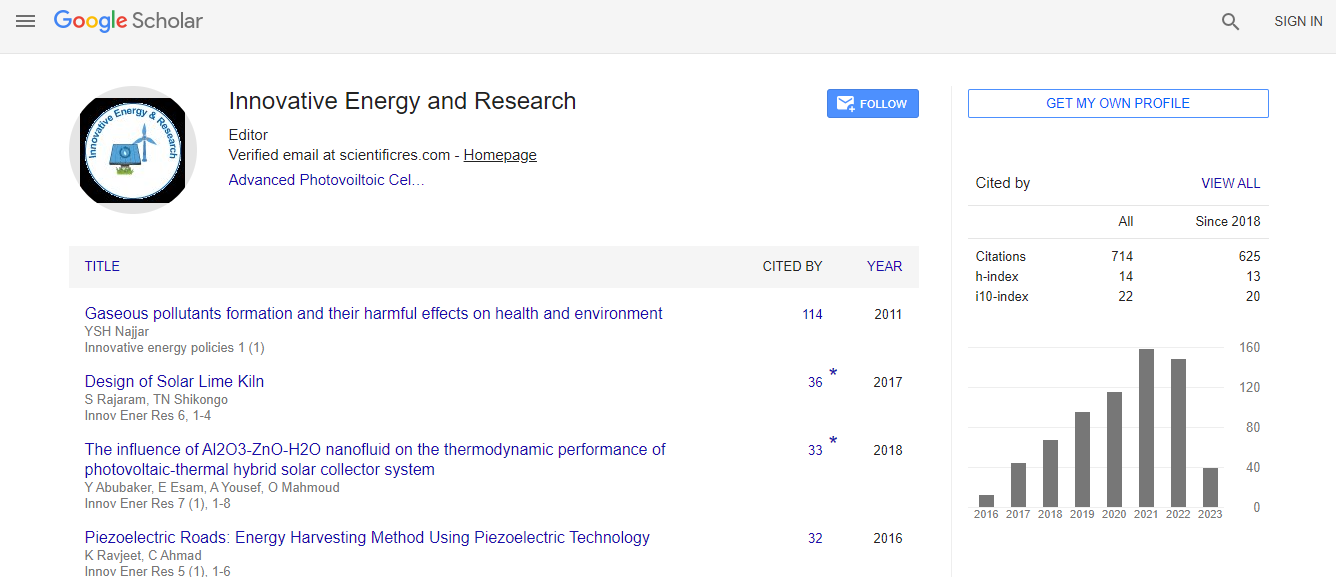Our Group organises 3000+ Global Conferenceseries Events every year across USA, Europe & Asia with support from 1000 more scientific Societies and Publishes 700+ Open Access Journals which contains over 50000 eminent personalities, reputed scientists as editorial board members.
Open Access Journals gaining more Readers and Citations
700 Journals and 15,000,000 Readers Each Journal is getting 25,000+ Readers
Google Scholar citation report
Citations : 712
Innovative Energy & Research received 712 citations as per Google Scholar report
Innovative Energy & Research peer review process verified at publons
Indexed In
- Google Scholar
- Open J Gate
- Genamics JournalSeek
- RefSeek
- Hamdard University
- EBSCO A-Z
- Publons
- Euro Pub
- ICMJE
Useful Links
Recommended Journals
Related Subjects
Share This Page
Cyclic oligosaccharide modification of lanthanide-doped upconversion nanoparticles: as novel nanostructural drug carriers via host-guest interactions
20th International Conference on Advanced Energy Materials and Research
Jun Ou
Guilin University of Technology, China
Posters & Accepted Abstracts: Innov Ener Res
Abstract
Statement of the Problem: Carbohydrates are biological macromolecules involved in life activities, not only providing energy and intracellular tissue support, but also mediating the occurrence of inflammatory reactions, affecting cell growth, division, differentiation, and transduction of intercellular cell signaling. However, low targeted delivery and lack of fluorescent labeling are two major problems with natural polysaccharide (GA) drugs. The purpose of this study is to describe the experience of designing a unique pH-sensitive drug carrier based on host-guest interaction between rhodamine and β-cyclodextrin. This strategy can be extended to other pH-sensitive drug delivery system. Methodology & Theoretical Orientation: UCNPs were synthesized following Chemical protocol. Rhodamine was conjugated with Ganoderma applanatum polysaccharide (GAP) through reductive amination reaction to form rhodamine polysaccharide complex (R-GAP). The cytotoxicity of CD-UCNPs and R-GAP-CD UCNPs was examined using a methyl thiazolyl diphenyl tetrazolium (MTT) assay. Findings: The UCNPs were synthesized using a typical solvothermal method and UCNPs were modified with β-CD to form a water-solubility nanocarrier. Rhodamine was conjugated with GAP through reductive amination reaction to form R-GAP so that it makes the GAP fluorescently trackable. R-GAP was loaded on CD-UCNPs and estimated the drug loading and releasing behaviors. The results revealed that it was a good pH-sensitive drug carrier and the maximum release amounts of R-GAP reach up to 67.2% after incubated in PBS for 36 h at pH 5.5. Conclusion & Significance: The strategy described in this work is simple and effective to fluorescently mark the GAP and can enhance the targeting delivery. This article give an evidence to improve natural polysaccharide antitumor drug efficiency by a proper modifications.Biography
E-mail: gloujun@glut.edu.cn

 Spanish
Spanish  Chinese
Chinese  Russian
Russian  German
German  French
French  Japanese
Japanese  Portuguese
Portuguese  Hindi
Hindi 
